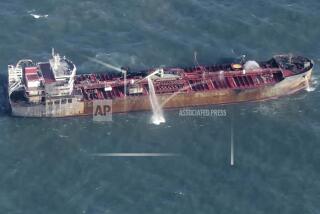Weather Slows Cleanup of Oil Spill
- Share via
SEATTLE — Savage weather Monday hampered oil cleanup efforts at the site of last week’s freighter wreck off Alaska’s Aleutian Islands, but Coast Guard officials also said the damage from the oil spill did not appear as extensive as they had first feared.
Several booms have been set in place to contain the slick from the Malaysian-registered Selendang Ayu, which split in two Wednesday after its engines failed and the craft ran into shoals off Unalaska Island, about 800 miles southwest of Anchorage.
Rough seas, frigid temperatures and limited daylight have made cleanup operations extremely difficult, said Coast Guard Capt. Ron Morris, the federal incident commander on the scene.
“The forward section is awash,” Morris said in a telephone briefing from Dutch Harbor for reporters. “The waves are coming over the deck.”
There was some relative good news, though, Morris said. The bunker-fuel tank that had been most severely breached in the crash of the freighter, originally thought to be nearly at its 140,000-gallon capacity, had only about 40,000 gallons at the time of the accident.
A separate tank, with about 104,000 gallons of the heavy oil, did not appear to have fallen apart, Morris and other officials said.
But stabilization and recovery efforts were proving arduous, and efforts to get large pump-bearing ships into the area were put off Monday.
“It’s just too dangerous,” said Leslie Pearson, the prevention and emergency-response manager for the state’s Department of Environmental Conservation.
Officials were hoping for a break in the weather that could allow heavy-lift helicopters to fly tanks into the area, so the oil could be pumped into the tanks.
The freighter wreckage is about eight hours by boat from the nearest commercial port, at Dutch Harbor.
Six crew members of the 738-foot-long ship died in the accident, including several who had initially been rescued by a Coast Guard helicopter that subsequently crashed. The helicopter’s three crew members and one rescued worker survived.
All told, the ship was carrying nearly 500,000 gallons of fuel, about 1/20th the amount carried by the Exxon Valdez, which ran aground near the oil port of Valdez in Prince William Sound in 1989. Very little of the Selendang Ayu’s fuel has been recovered, in part because it has congealed into a form that traditional skimming equipment on board the ship at the wreckage scene cannot pick up.
“They have been encountering heavy sheen and tar balls but no recoverable oil,” said Gary Folley, the on-scene coordinator for the state of Alaska. Tar balls are heavy globs of oil mixed with rock or dirt, generally ranging in size from a ping-pong ball to a large grapefruit.
At best, salvage crews would be able to stabilize and tow the rear section of the boat and limit the amount of the spill. But with weather and other conditions working against them, they may be unable to do so before the pounding surf breaks it apart.
The Selendang Ayu was carrying soybeans to China from Seattle when it went adrift. The exact cause of the engine failure has yet to be determined.
The extent of wildlife damage remained unclear Monday.
In the last few days, officials said, rescue workers have seen several dead cormorants and other birds, and they fear endangered sea lions and seals in Skan Bay, near the wreckage, could die.
More to Read
Sign up for Essential California
The most important California stories and recommendations in your inbox every morning.
You may occasionally receive promotional content from the Los Angeles Times.












